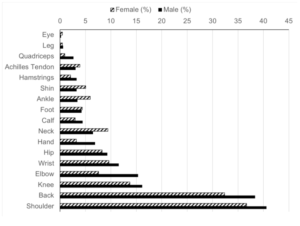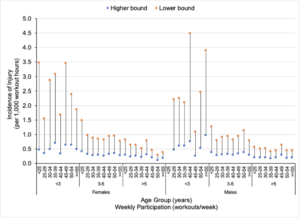”Ohio, have you heard of high intensity functional training (HIFT)? HIFT has a reputation for having higher injury risk. This week's article discusses the latest research on injury and HIFT. We hope this helps you make an informed decision on whether HIFT is right for you. Enjoy!
Reading time: 12 Minutes
MWi Hacks:
- Gain a deeper understanding of injury risk when trying high intensity training
- Find new confidence in trying a training methodology that has proven health and wellness results
MWi Summary:
- High intensity functional training (HIFT) has been shown to have clear physiological benefits. What is less clear is the injury risk associated with HIFT.
- When going through research on HIFT (and any other topic) it’s important to distinguish between prevalence and incidence.
- Prevalence refers to the total number of cases during a specified time period.
- Incidence is the number of new cases during a specific time period.
- One of the larger studies on HIFT and risk of injury showed low incidence of injury with an inverse relationship between number of workouts per week and rate of injury. The risk of injury is overall similar to other training modalities.
Is high intensity functional training really dangerous?
Even though a lot has been written about the benefits of high intensity functional training (HIFT) exercise over the decade (Feito, Yuri, Brown, & Olmos, 2019; Feito, Y, Heinrich, Butcher, & Poston, 2018), the evidence is clear regarding the physiological benefits associated with this training modality – i.e. increased aerobic capacity, fat loss, strength gains, etc. However, what seem a little less clear is the potential risk of injury associated with this training modality.
Definition of terms
To better understand the data presented in these studies, it is important to understand some of the variable typically measured. In this case two terms come to mind – prevalence and incidence. Although often confused, these numbers are calculated differently and represent different portions of a specified population. Whereas prevalence refers to the total number of cases (individuals who have a condition) during a specific period in time, incidence is specific to the number of new cases (individuals who have develop a condition) during a specific period of time.” As such, the two numbers should not be interpreted the same. Prevalence, typically reported as a percentage (%), provides an overall valuable that is difficult to compare unless the comparison groups are similar. Incidence, on the other hand, allows for direct comparisons between studies, as it represents the total of new cases within a specified portion of the population (e.g. typically presented as a rate per 1,000 or 100,000 cases).
The Numbers
Over the last five-years several reports have been published regarding this topic. However, most have been relatively small cross-sectional studies that provide valuable data in this area, yet limit the generalization of their results considering the small number of participant evaluated. However, in 2018 our laboratory published a multiyear study with over 3,000 participants (88% form US, 12% International) and provided a more comprehensive look at the prevalence and incidence of injuries as a results of HIFT exercise (Feito, Y., Burrows, & Tabb, 2018).
In that study, of the 3,049 participants who complete our survey over a four-year period we report an injury prevalence of 30%, meaning 30% of the participants who responded to our survey reported some type of injury. Overall, the shoulders (39%), back (36%), knees (15%), elbows (12%), and wrists (11%) were the most common body parts injured (Figure 1); these were similar for both male and females.

Figure 1: Prevalence of reported injuries by body part (Adapted from: Feito, et al. 2008)
Unlike other studies where incidence rates have been calculated based on the number of days a workout is completed, our study provides incidence rates based on the number of workouts an individual reported per week. We felt this strategy would provide a more accurate level of risk, as each workout provides an opportunity for injury. Moreover, we felt providing a higher- and lower range would be appropriate as time (in this case weeks) is necessary to calculate the incidence rate.
Overall, our study showed a relatively low incidence of injury with an inverse relationship emerging between number of workouts per week and the rate of injury exist (Figure 2). More specifically, those who completed less than three workouts per week, had a higher risk of being injured – regardless of age. Suggesting that experience and continued practice may be protective of injury, after all.

Figure 2: Incidence rates among HIFT participants (Adapted from: Feito, et al. 2008)
Take home message
Even though we are still learning more about the potential risks of this new training modality, it seems that similar to more traditional exercise modes, practice and continued participation may be protective and lead to lower injury risks.
Dr. Feito on Twitter @DrFeito
More about the Expert:
Yuri Feito, PhD, MPH is an associate professor of exercise science at Kennesaw State University. He has been involved in the medical fitness industry for over 20 years working with a variety athletes and clinical populations. Dr. Feito obtained a Ph.D. from the University of Tennessee, Knoxville and has master’s degrees in Movement Science and Public Health. He is fellow of the American College of Sports Medicine and is certified as a clinical exercise physiologist and CrossFit Level 2 Coach. His current research examines the psychobiological mediators that enhance participation in high-intensity functional training (HIFT), and determine the effectiveness of HIFT exercise as a modality to reduce cardiovascular disease risk factors among individuals of diverse backgrounds and prevent injuries. The overall objectives of his research are to (1) determine potential barriers to HIFT exercise, (2) evaluate the affective response to HIFT sessions, and (3) asses the acute response of cardiometabolic health markers among adults. A list of current publications can be accessed at: http://www.bit.ly/Scholar_DrFeito
References
Feito, Y., Brown, C., & Olmos, A. (2019). A content analysis of the high-intensity functional training literature: A look at the past and directions for the future. Human Movement, 20(2), 1-15. doi: 10.5114/hm.2019.81020
Feito, Y., Burrows, E.K., & Tabb, L.P. (2018). A 4-year analysis of the incidence of injuries among crossfit-trained participants. Orthop J Sports Med, 6(10), 2325967118803100. doi: 10.1177/2325967118803100
Feito, Y., Heinrich, K.M., Butcher, S.J., & Poston, W.S.C. (2018). High-intensity functional training (hift): Definition and research implications for improved fitness. Sports (Basel), 6(3). doi: 10.3390/sports6030076






